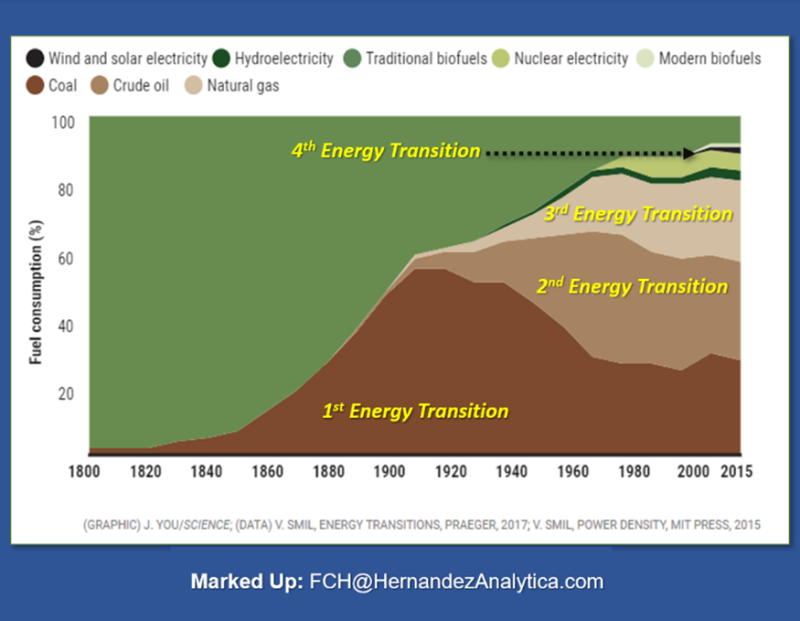In this article, I will share my journey of how working on offshore projects with remotely operated vehicles (ROVs) led me to embrace the concept of the "Energy Basket," a non-binary approach to energy. In the image above I am holding an ROV’s arm.
I became a proponent of the energy basket, while deployed offshore, as it became apparent that an ROV’s upward and downward movement (heave) could be harnessed as a renewable energy to power subsea equipment. This led me to filing a patent in 2012, which was granted in 2016. The patent details a novel subsea device that closes the rams on a subsea blow out preventer —using a renewable source—to control hydrocarbon production in emergencies, and it embodies the energy basket concept. Whether on land or subsea, the basket is acceptant of different forms of energy inputs and is non-binary. Looked at differently, the basket foregoes an us-versus-them philosophy in terms of pinning renewables against hydrocarbons.

Fig.1—ROV before being deployed subsea.
A Global Lens on Energy Transitions
Over the course of my career—spanning more than 15 years—I have worked on projects in developed and developing nations. This first-hand experience made me realize that the world is not black and white, in that that no one energy resource will quickly replace the current global energy mix. For context, the current fourth energy transition looks to displace the previous three transitions with entirely renewable energy, which was bolstered by the Paris Agreement of 2015. However, the first transition gained a pronounced role in the 1800s, when coal consumption increased, followed by oil, and then natural gas.
Although there is no universal definition for the term energy transition, it generally describes the global change in primary energy supply, pertaining to the composition. Vaclav Smil in his book Energy Transitions: Global and National Perspectives, describes the first three transitions in civilization as humans mastering fire by burning plants to free sun’s energy; farming, which converted solar energy to food; and industrialization, with CO2 as the primary energy source. The third civilization transition ushered in the era of industrialization, which gave birth to the first energy transition to coal.

Fig. 2—A view of the energy transitions.
Will the fourth energy transition eventuate as envisaged, in terms of the time by which it replaces its predecessors? In the immediate short-term this is unlikely, which is why some countries have principally set 2050 Net Zero objectives, as opposed to decarbonizing by 2025. Notwithstanding, such timetables should not dissuade energy basket collaboration. It is key to note that for a transition to occur, a global share of consumption must be attributed a particular energy source: the fourth transition has yet to achieve this.
As an appointed technology mentor for Scotland’s Oil and Gas Technology Centre (now called Net Zero Technology Centre [NZTC]), I am able to increase my collaboration with companies that are actively developing solutions in the following areas: generating green hydrogen produced by offshore windfarms, carbon capture utilization storage solutions, biotechnologies for the circular economy, and low carbon developments.
A recently announced OGTC program is an example of the energy basket. The program is a consortium of companies, consisting of Baker Hughes, Harbour Energy, EG-OC, and Mocean Energy, with the objective to convert wave energy into electrical energy to power subsea production systems (SPS) for producing hydrocarbons as well as autonomous underwater vehicles (field trials expected in 2021).
The inclusion of EC-OG’s subsea battery equipment adds a layer of unique intelligence to this consortium project. This is due the fact that such equipment ensures that the output energy from Mocean Energy’s wave technology can be stored, and equally distributed, ensuring that energy is not squandered during its generation. Moreover, Baker Hughes’ SPS and hydrocarbon production experience can harness the subsea battery’s energy to power subsea equipment and architecture (lessening CO2 emissions), while equally enabling telemetry and communications. The involvement of Harbour Energy, a leading independent oil company in the North Sea, creates the opportunity for potential adoption by an oil company (this will be driven by upcoming field trials). These developments speak to the growing practical implementation of the basket concept.
As the world grapples with the fourth energy transition, I believe that the energy basket concept can provide a space for co-existence of different resources in the realm of global energy, while promoting collaboration and partnerships rather than differences. We are at a pivotal junction, as countries across the globe have, at least in letter and some in spirit, started to equally develop strategies to mitigate CO2 emissions. The corporate world isn’t behind as some of the recent developments manifest. Change is evident, but it will take time as the world maneuvers through the ebbs and flows, in terms of the rhetoric versus reality of the energy transition. The International Energy Agency issued the impactful Net Zero by 2050 report, which pronouncedly expressed the need to shift from hydrocarbon investments. However, they also later remarked that “OPEC+ needs to open the taps to keep the world oil markets adequately supplied.”
In closing, I would like to acknowledge the many innovative startups linked to NZTC. Their pioneering spirit goes beyond rhetoric and policy on energy, and they are diligently positioned at the forefront of developing technologies for the present and future. My gratitude extends to Mark Rossano, CEO of C6 Capital Holdings, who provided direct mentorship and pivotal insights on the importance of the energy basket in the 21st century.


